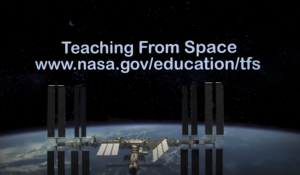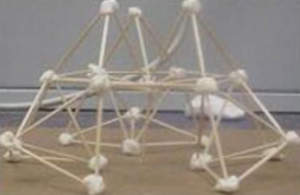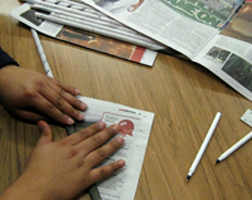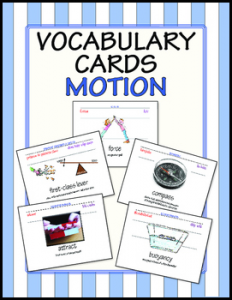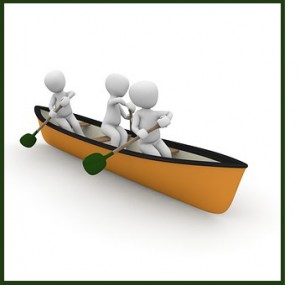Here’s an amazing resource I added to the Newton’s Laws web page – sixteen short videos posted by NASA that you’ll want to show your students. Each video introduces a common toy and demonstrates how it’s used on Earth and then on the International Space Station.
Cut and fold paper to create a helicopter that spins as it’s dropped to the floor. Create a second helicopter but this time change the size or mass of the helicopter. It can be hard to time a helicopter as it drops so consider dropping the two helicopters to determine if the change affects how the helicopter falls to the floor. For more about this activity, check out these resources: eGFI Dream Up the Future or a FREEBIE created by Bryce Hixson. My students enjoy this activity so much I included it in my Pushes and Pulls product at TpT.
Here’s another activity to consider that requires less common materials, raw spaghetti and miniature marshmallows. You’ll want to set aside time if your students love this activity like mine do. Suggested grade level is sixth. Younger students might struggle with being patient and handling small materials. If you have younger students you might use tape instead of marshmallows to create towers. After your students complete their structures consider, if space allows, leaving them out on a shelf. As the marshmallows dry the structures remain intact. Kids love seeing their work displayed in the room! You might view this TED talk to find out why kindergarten students are better at this kind of …
Need a quick activity that requires only newspaper and tape? Maybe an activity for a family science night? www.flickr.com/photos/vinzcha/ / CC BY 2.0 Consider this online resource adapted from PBS that combines science and engineering. It includes a clearly written procedure, vocabulary, background, and suggestions for an assessment. It could be completed by teams of engineer/scientists in your classroom! My students love this activity. The site suggests 20 minutes but my students always ask for more time to try variations they’ve seen other teams attempt. That’s what scientists do right, build on each other’s work?
Teaching a unit about force? Poetry can be a great addition to your science resources. Read about ten ways to use poetry in your classroom from Reading Rockets. In addition to my list of poetry by Shel Silverstein, here are suggestions for poems you might consider sharing with your students. The Butterfly Jar, Jeff Moss force: “London Bridge” A Pizza the Size of the Sun, Jack Prelutsky buoyancy: “We Often Walk on Water” magnetism: “I’m Practically Covered with Needles and Pins” Something Big has Been Here, Jack Prelutsky force: “The Turkey Shot Out of the Oven” These could support activities …
While teaching a university class, my teacher participants asked me about strategies for learning new science vocabulary. What resources could be used to help students learn key words for a new science topic? I created a set of cards for a variety of topics that have an image, a simple definition in English, and the term in English, Spanish, Vietnamese, and Russian. You can choose from: astronomy, birds, wild cats, frogs, geology, insects, motion, weather, and whales. Consider these other resources: Increasing vocabulary is an accomplishment. Celebrate mastery of every word!– Marilee Sprenger in Education Week Teacher Rigorous and meaningful vocabulary activities can …
Here is a list of poetry by Shel Silverstein to consider adding to your resources for teaching about force and motion unit. These could support activities that meet NGSS 3-PS2-1♦ and 3-PS2-2â—Š. A Light in the Attic, Shel Silverstein force: “ADVENTURES OF A FRISBEE” inertia: “FANCY DIVE” pendulums: “HOW TO MAKE A SWING WITH NO ROPE OR BOARD OR NAILS” Every Thing On It, Shel Silverstein gravity: “THE JUGGLER” gravity: “TURNING INTO” gravity: “GOOD IDEA” gravity: “LOVE IS GRAND BUT…” Falling Up, Shel Silverstein buoyancy: “SOMETHIN’ NEW” gravity: “FALLING UP” Where the Sidewalk Ends, Shel Silverstein buoyancy: “HOMEMADE BOAT” friction: “MAGICAL ERASER” …
A science lesson doesn’t have to take 40 minutes or even several sessions of 40 minutes. It needs to be focused on the science you’re presenting, be interesting, and, of course, be fun! I’m teaching inertia and gravity in a fifth grade classroom. Between my 40 minute classes I want to keep students interested and talking about the topic. I could use a few short demonstrations to review or reinforce inertia and gravity. Do you have a meter stick? Try this Center of Gravity demonstration. Do you have a large glob of clay to add to the meter stick? Try this Balancing …
